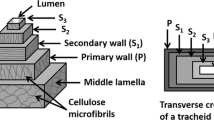Abstract
Techniques which are readily available, and which may be considered suitable for the qualitative or quantitative assessment of fibre orientation distribution in short glass fibre-reinforced thermoplastics are reviewed. The results of using several of these techniques in structural studies on injection mouldings of glass fibre-reinforced grades of polypropylene and polyamide 66 are presented. Uniaxial tensile creep tests were carried out on specimens cut from the mouldings and the anisotropy of stiffness of each moulding is compared with that predicted from the structural studies. Certain of the structural techniques are considered to be unreliable or of restricted applicability and it is concluded that the technique of contact micro-radiography is the most versatile; being capable of yielding reliable qualitative or quantitative information on fibre orientation distribution. Detailed structural studies on edge-gated injection moulded discs, using the technique of contact micro-radiography, show that the fibre orientation distribution varies dramatically through the thickness of the mouldings, even in cases where uniaxial tensile creep tests suggest isotropy of stiffness in the plane of the moulding. Care must therefore be taken when seeking to relate flexural data to tensile data and strength data to stiffness data.
Similar content being viewed by others
References
H. S. Loveless and D. E. McWilliams, Poly. Eng. Sci. 10 (1970) 139.
C. M. R. Dunn and S. Turner, “Composites — Standards Testing and Design”, N.P.L. April 1974. Proceedings (IPC Science and Technology Press, 1974, Guildford) p. 113.
M. W. Darlington and P. L. McGinley, J. Mater. Sci. 10 (1975) 908.
M. W. Darlington and D. W. Saunders, J. Phys. E: Sci. Instrum. 4 (1970) 511.
M. W. Darlington and D. W. Saunders, Anisotropic creep behaviour, in “The structure and properties of oriented polymers”, edited by I. M. Ward (Applied Science, 1975, London) Ch. 10.
S. Turner, Trans. J. Plast. Inst. 31 (1963) 60.
M. W. Darlington and G. R. Smith, Polymer 16 (1975) 459.
D. C. Fuccella, 27th Annual Technical Conference of Reinforced Plastics/Composites Institute, S.P.I., Section 11 - F (1972).
V. Karpov and M. Kaufman, British Plastics 38 (1965) 498.
E. M. Rowbotham, S. A. E. Automotive Engineering Congress, Detroit, Michigan, 740264 (1974).
J.-M. Charrier and M. J. Sudlow, Fibre Sci. Technol. 6 (1973) 249.
E. Jinen and M. Suzuki, Kobunshi Kagaku 30 (1973) 144.
A. Nemet, A. D. Black and W. F. Cox, Trans. J. Plast. Inst. 30 (1962) 192.
W. R. Schlich, R. S. Hagan, J. R. Thomas, D. P. Thomas and K. A. Musselman, S.P.E.J. 24 (1968) 43.
A. D. S. Diggwa and R. H. Norman, Plast. Polym. 40 (1972) 263.
W. H. Bowyer and M. G. Bader, J. Mater. Sci. 7 (1972) 1315.
D. V. Badami, private communication.
C. M. R. Dunn and S. Turner, private communication.
G. W. Weidmann and R. M. Orgorkiewicz, J. Mater. Sci. 9 (1974) 193.
Author information
Authors and Affiliations
Rights and permissions
About this article
Cite this article
Darlington, M.W., McGinley, P.L. & Smith, G.R. Structure and anisotropy of stiffness in glass fibre-reinforced thermoplastics. J Mater Sci 11, 877–886 (1976). https://doi.org/10.1007/BF00542305
Received:
Accepted:
Issue Date:
DOI: https://doi.org/10.1007/BF00542305



